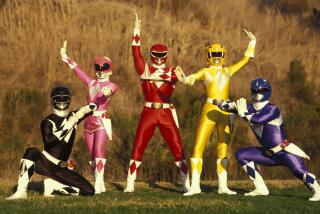Power Rangers Still Have a Kick
- Share via
It’s been called the Energizer bunny of the kid television world. It’s also been a long-lasting bane to many a parent whose child has karate-kicked a classmate in a playground reenactment of the show.
“Power Rangers,” now in its ninth year, is surviving in a TV marketplace where shows, especially those for young viewers, can burn brightly and quickly burn out. It’s not the phenomenon it was in the early ‘90s, when parents camped out on sidewalks to buy then-scarce toys and kids went into a Beatlemania-style frenzy when the Rangers hit town, but it’s far from being passe.
The Fox series has become a rite of passage for young boys, who consistently keep it at the top of the ratings in the 2-11 age group. And in the recently completed May sweeps, the show was No. 1 among both broadcast and cable series in its Saturday morning time slot with boys 6-11, according to Nielsen Media Research.
Though it’s stylized and ironic, “Power Rangers” spawned legitimate concerns among parents, according to those who study the effects of action-oriented TV on kids. But the rise in recent years of more violent kid-targeted entertainment has made the show less of a target.
“Something like ‘Power Rangers’ seems almost quaint by comparison to the far more gruesome and super-realistic entertainment available now online and in video games,” said Mark Crispin Miller, professor of media studies at New York University. “But the fact remains that a steady diet of such shows coarsens a kid’s appetite. It’s overstimulation. It discourages them from sitting through quieter TV shows with an educational or informational focus.”
Along with the punching and kicking are lessons that can’t be overlooked if the show is to get a fair assessment, some academics say. “Everybody knows what the criticisms are, and we all know that kids shouldn’t spend a lot of time watching violent programs,” said Gordon Berry, professor emeritus at UCLA, who studies media and social behavior. “But other qualities of the show have to be considered. It has heroes of both genders, a multiethnic cast and characters that stand up for what’s right.”
Whether those factors mitigate the action, though, is a question for which Berry says he doesn’t have the answer.
Meanwhile, kids keep watching and buying. “Power Rangers” has spawned more than $5.6 billion in sales worldwide of its show-inspired tchotchkes--from toys and clothing to vitamins and canned pasta. It still lands cross-promotions with McDonald’s and valuable shelf space at Target and Kmart.
And in the face of powerhouse kid properties like Pokemon, Star Wars, WWF and GI Joe, Power Rangers was named the best-selling action toy of the ‘90s by NPD Group, an industry tracking service.
“Adults might have forgotten about it, but kids haven’t,” said Elie Dekel, president of Saban Consumer Products, the licensing division of Fox Family Worldwide.
All this from a Japanese import that was camp with a capital “C” when it arrived on the air in August 1993. The show--its current incarnation is called “Power Rangers Time Force”--has lasted far longer than anyone expected. Jonathan Tzachor, who has been the show’s executive producer from the start, said he initially didn’t understand the concept or its potential.
“I thought it was crazy; I didn’t get it at all,” Tzachor said. “It was naive and simplistic, and it didn’t look like anything else on TV.”
The live-action show was adapted from a kid series in Japan called “Xyu Rangers,” now in its 25th season. Initially, more than half the show that aired in the U.S. was lifted directly from the Japanese version. That’s since dropped to about 10% Japanese footage. For an American audience, pop music was added, as was a multicultural cast.
“Power Rangers” mania began within months of its premiere. The first few appearances by the Rangers, at Topanga Plaza and Universal City, were mobbed by thousands of kids and their head-scratching parents. Criticism of its on-screen fisticuffs just made it more appealing to its core 3- to 8-year-old-boy viewer. It eventually inspired two feature films, a direct-to-video movie and merchandise from more than 50 companies.
What goes up, inevitably, must come down, and the show’s novelty began to wear thin after about two years. Retailers declared it all but dead. The show’s producers began to look for ways to revive it.
They decided the Rangers, settings and scenarios should change each season, which has put the characters in space, on the moon and under water, aiming to reflect whatever’s in the kid zeitgeist at the moment. Shows are produced close to air date, meaning that a subject or trend that’s hot with kids can be quickly incorporated into the episodes.
Plot Lines Have Become More Complex
The Rangers currently time-travel. Production values have improved dramatically and story lines have become more complex. Most of the camp has been stripped out, though Tzachor says some of the silly fun might be re-injected later.
Still the central plot of the show remains the same. In each of its 400-plus episodes, teens turn into superheroes to save the planet. There’s no gray area--the kids are all good, and the villains are all evil. There’s lots of acrobatics, special effects and fighting, but no one dies. The bad guys are shrunk to miniature size, for instance, and tossed in jail rather than beaten.
The core viewer has gotten younger, as with many kid shows, but there seems to be a never-ending crop of 3- to 8-year-olds growing into “Power Rangers.”
“It’s become like Barbie,” said Bill Beebe, senior vice president of marketing at the Bandai toy company, which has more than 600 Power Rangers toys. “Kids can feel like they’ve discovered it because it’s all new. It’s fresh to them.”
*
“Power Rangers Time Force” can be seen Saturdays at 7:30 a.m. and 10 a.m. on Fox. The network has rated it TV-Y7-FV (may be unsuitable for children younger than 7 with special advisories for fantasy violence).
More to Read
The complete guide to home viewing
Get Screen Gab for everything about the TV shows and streaming movies everyone’s talking about.
You may occasionally receive promotional content from the Los Angeles Times.






